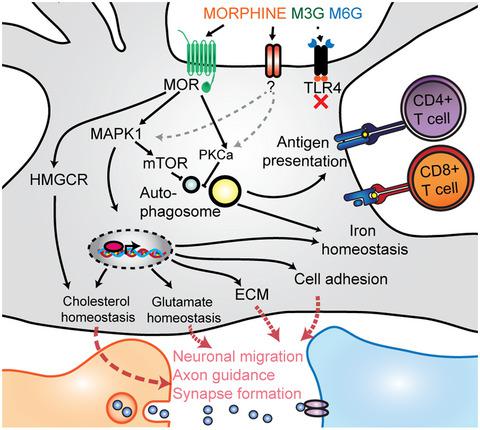当前位置:
X-MOL 学术
›
J. Neurosci. Res.
›
论文详情
Our official English website, www.x-mol.net, welcomes your feedback! (Note: you will need to create a separate account there.)
Deep proteomics and phosphoproteomics reveal novel biological pathways perturbed by morphine, morphine-3-glucuronide and morphine-6-glucuronide in human astrocytes
Journal of Neuroscience Research ( IF 4.2 ) Pub Date : 2020-09-20 , DOI: 10.1002/jnr.24731 Vito Dozio 1, 2 , Youssef Daali 2, 3 , Jules Desmeules 2, 3 , Jean-Charles Sanchez 1, 2
Journal of Neuroscience Research ( IF 4.2 ) Pub Date : 2020-09-20 , DOI: 10.1002/jnr.24731 Vito Dozio 1, 2 , Youssef Daali 2, 3 , Jules Desmeules 2, 3 , Jean-Charles Sanchez 1, 2
Affiliation

|
Tolerance and hyperalgesia associated with chronic exposure to morphine are major limitations in the clinical management of chronic pain. At a cellular level, neuronal signaling can in part account for these undesired side effects, but unknown mechanisms mediated by central nervous system glial cells are likely also involved. Here we applied data-independent acquisition mass spectrometry to perform a deep proteome and phosphoproteome analysis of how human astrocytes responds to opioid stimulation. We unveil time- and dose-dependent effects induced by morphine and its major active metabolites morphine-3-glucuronide (M3G) and morphine-6-glucuronide that converging on activation of mitogen-activated protein kinase and mammalian target of rapamycin signaling pathways. We also find that especially longer exposure to M3G leads to significant dysregulation of biological pathways linked to extracellular matrix organization, antigen presentation, cell adhesion, and glutamate homeostasis, which are crucial for neuron– and leukocyte–astrocyte interactions.
中文翻译:

深度蛋白质组学和磷酸化蛋白质组学揭示了人类星形胶质细胞中吗啡、吗啡-3-葡萄糖苷酸和吗啡-6-葡萄糖苷酸干扰的新生物学途径
与长期暴露于吗啡相关的耐受性和痛觉过敏是慢性疼痛临床管理的主要限制。在细胞水平上,神经元信号可以部分解释这些不良副作用,但可能还涉及由中枢神经系统神经胶质细胞介导的未知机制。在这里,我们应用与数据无关的采集质谱法对人类星形胶质细胞对阿片类药物刺激的反应进行深度蛋白质组和磷酸化蛋白质组分析。我们揭示了吗啡及其主要活性代谢物 morphine-3-glucuronide (M3G) 和 morphine-6-glucuronide 诱导的时间和剂量依赖性效应,它们收敛于促分裂原活化蛋白激酶和雷帕霉素信号通路的哺乳动物靶点的激活。
更新日期:2020-09-20
中文翻译:

深度蛋白质组学和磷酸化蛋白质组学揭示了人类星形胶质细胞中吗啡、吗啡-3-葡萄糖苷酸和吗啡-6-葡萄糖苷酸干扰的新生物学途径
与长期暴露于吗啡相关的耐受性和痛觉过敏是慢性疼痛临床管理的主要限制。在细胞水平上,神经元信号可以部分解释这些不良副作用,但可能还涉及由中枢神经系统神经胶质细胞介导的未知机制。在这里,我们应用与数据无关的采集质谱法对人类星形胶质细胞对阿片类药物刺激的反应进行深度蛋白质组和磷酸化蛋白质组分析。我们揭示了吗啡及其主要活性代谢物 morphine-3-glucuronide (M3G) 和 morphine-6-glucuronide 诱导的时间和剂量依赖性效应,它们收敛于促分裂原活化蛋白激酶和雷帕霉素信号通路的哺乳动物靶点的激活。



























 京公网安备 11010802027423号
京公网安备 11010802027423号